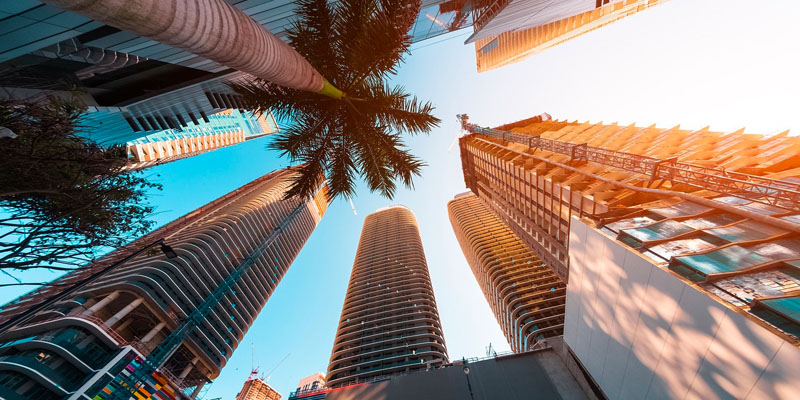
Located on the east coast of the United States , on the beautiful Florida peninsula, Miami has become one of the most interesting sun and beach tourist destinations in the country. With an undoubted Latin influence for decades, this place is a very special place and different from any other in the United States , having so much diversity in its streets, with a lot of companies of all kinds, both large conglomerates and small businesses, and of course, for having paradisiacal beaches that stand out on the East coast of the United States. Currently, the Miami metropolitan area is among the ten largest in the country, despite the fact that the city has barely more than 120 years of life. Its growth has been exponential in recent decades, and it has become one of the epicenters of the great Latin wave in the United States , due to its proximity to Cuba, Puerto Rico and Mexico.
In fact, Miami is recognized as the American refuge for many artists and content creators in Spanish, both Latin American and Spanish. But also for having the port with the highest volume of cruise ships a year in the world , the highest concentration of international banks in the entire country, and being one of the few places where Spanish is the official language for administration, since in Miami-Duke County, in which the city is head of administration, more than 70% of the inhabitants are Spanish speakers . Around it, throughout Florida, we find places of interest such as amusement parks or the Everglades , but it is not necessary to leave the city itself to enjoy places with a lot of charm and tourist interest, as we will see.
The walls of Wynwood
Miami , like so many other large cities, is divided into different neighborhoods, many of them related to a specific nationality, due to the large number of people of that origin or nationality living there. From Little Havana to Doral , these neighborhoods function almost like small homelands for those nationalities, and visiting them is like enjoying all of Latin America in just a few streets.
One of the most popular is Wynnwood , also known as Little San Juan , due to the large number of Puerto Ricans who live there. The neighborhood has shops of all kinds and very colorful streets that are worth a walk, to see its walls, many of them murals created by local artists, but also by other world-class artists. The Wynwood Walls is the only street art park in the city, and is open to the public all year round for free.
Brickell and Downtown Miami
The Downtown is the center of the city, the place where we can find the greatest number of shops, banks and important companies. It is not uncommon to see big skyscrapers , huge conglomerates and parks where executives try to disconnect a bit from their busy work rhythm.
This financial district , within the nerve center of Miami, is called Brickel , and it is very curious to see the difference between it and those around it, where we find Much older churches and monuments, mixed with those imposing and gigantic skyscrapers that are the headquarters of many important companies in the city. Taking a walk around Downtown is essential to understand Miami in all its magnitude.
The best museums in the city
Despite being a very young city, Miami has a wide variety of museums that will delight the most curious, those who want to know the legacy of everything that existed before the city, the history of it or the secrets of the exotic flora and fauna of the place. Beyond the Wynwood Walls , which can be considered an open-air museum, we can visit the Vizcaya Museum and Gardens , one of the most special in the city, based on its history local.
The Miami Design District , located north of Downtown, also has several museums and galleries of modern art and avant-garde design. The Children’s Museum is a good alternative to go with the little ones, while the Pérez Arts Museum is one of the most prominent in terms of its pictorial works.
Ocean Drive and Art Deco District
If you like going out and want to enjoy all that Miami has to offer, don’t hesitate to visit Ocean Drive. This gigantic avenue, located next to South Beach, is the epicenter of all the nightlife in the city. city, and during the day it also bustles with people coming and going to the beach.
Sculptural bodies, surfers wanting to catch waves or simply visitors enjoying the great atmosphere that is breathed in this area make Ocean Drive an essential visit if we are in Miami. And to finish our walk, right at the southern end of South Beach we will find the Art Deco District , a neighborhood with hundreds of buildings created based on this peculiar architectural style, that attract a lot of attention among the great amalgam of buildings in Miami.
Little Havana
Since Fidel Castro came to power in Cuba, many have been exiles who have found a new home in Miami. The majority of Cubans who live in the city do so in a neighborhood known as Little Havana, where we can find “replicas” of purely Cuban shops and restaurants, as if we were on the island. The famous Calle Ocho is a great shopping avenue where color is everything, and which speaks of the more than fifty years of the American dream that Cuban exiles have been building in Miami , missing his island a lot and trying not to lose its cultural characteristics, in a neighborhood that is full of son, flavor and a lot of color, thanks precisely to the Cubans.